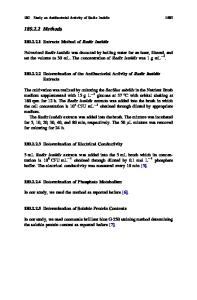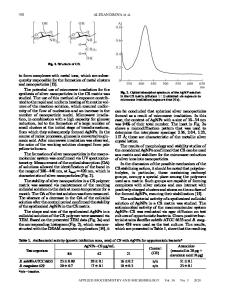Investigation of Structural, Optical and Antibacterial Activity of ZnS Nanoparticles
- PDF / 845,860 Bytes
- 8 Pages / 595.276 x 790.866 pts Page_size
- 5 Downloads / 383 Views
(0123456789().,-volV)(0123456789(). ,- volV)
ORIGINAL PAPER
Investigation of Structural, Optical and Antibacterial Activity of ZnS Nanoparticles S. Vijayan1,2
· Chandra Sekhar Dash3 · G. Umadevi1 · M. Sundararajan4 · R. Mariappan5
Received: 26 April 2020 / Accepted: 22 October 2020 © Springer Science+Business Media, LLC, part of Springer Nature 2020
Abstract Zinc sulfide (ZnS) nanoparticles have been successfully prepared by sol–gel precipitation method. The successful formation of cubic structure is ensured by XRD analysis and Debye Scherrer’s equation is used to determine the crystallite size which was found to be 36 nm for ZnS sample annealed at 200 °C. Surface morphology was studied using HRSEM as well as HRTEM and lattice parameters of the samples were obtained from SAED pattern which was found to have close resemblance to values attained from XRD pattern. Further elemental mapping of ZnS nanoparticles is confirmed by EDX studies. Further Kubelka Munk function was employed to estimate the band gap value which was seen lying within 3.58 to 3.64 eV. Further the antibacterial activity of ZnS is investigated and it is found to be an antibacterial agent of Escherichia coli and staphylococcus aurous, further it can be employed as an antimicrobial agent for prohibiting implant linked infections. Keywords ZnS nanoparticles · Cubic spinel · Optical properties · Vibrational spectra analysis
Introduction In nanoscale regime the inorganic composite Zinc Sulphide (ZnS) is a renowned wide band (II–VI) semiconductor that displays distinctive optical and electrical characteristics which make them appropriate for multiple applications and a band gap of 3.07 eV. It is broadly employed in
& S. Vijayan [email protected] & G. Umadevi [email protected] 1
Department of Physics, Govt. Arts College, Coimbatore, Tamil Nadu 641 018, India
2
Department of Physics, MGR College, Hosur, Krishnagiri, Tamil Nadu 635 130, India
3
Department of Electronics and Communication Engineering, Centurion University of Technology and Management, Odisha 752050, India
4
PG & Research Department of Physics, Paavendhar College of Arts & Science, M.V. South, Attur, Salem, Tamil Nadu 636 121, India
5
Department of Physics, Adhiyamaan College of Engineering, Krishnagiri, Tamil Nadu 635 130, India
applications viz. solid-state memory cells, solar cell, solar window layers, electroluminescent devices, flat panel and non-linear optical devices, photo catalytic degradation, FET, light emitting diodes [1–8]. The attractive characteristics offered by Zinc sulphide nanoparticles in comparison with bulk ZnS as follows: (a) increased ratio of surface with respect to volume, (b) higher optical absorption, (c) lower melting point and (d) quantum tunneling effect at macroscopic level. ZnS is a polycrystalline material which occurs in crystalline forms namely Zinc Blend (sphalerite) and Wurtzite, it possesses tetrahedral structure. Zinc blend and wurtzite occur in cubic form (fcc) and hexagonal form (hcp) respectively. Several attempts have
Data Loading...











